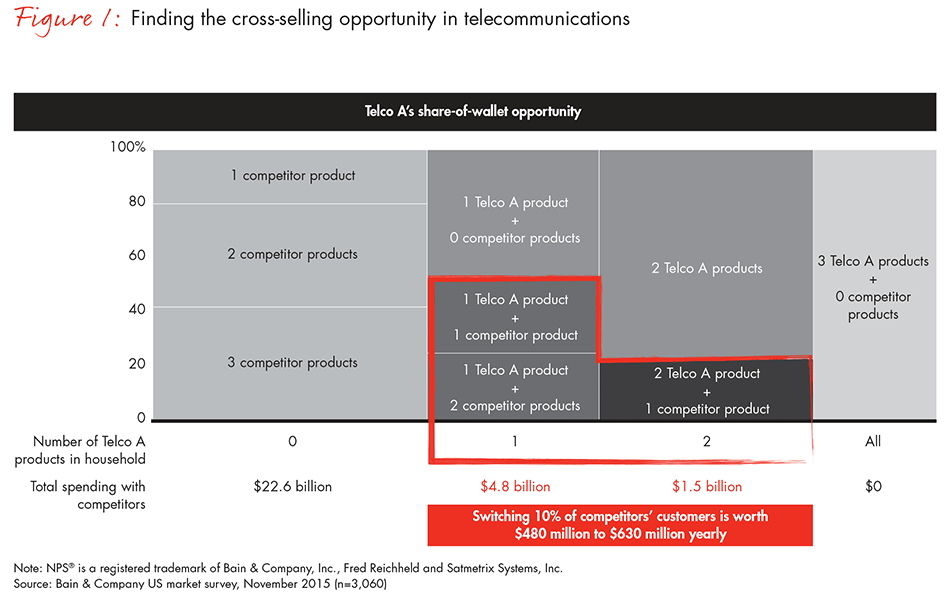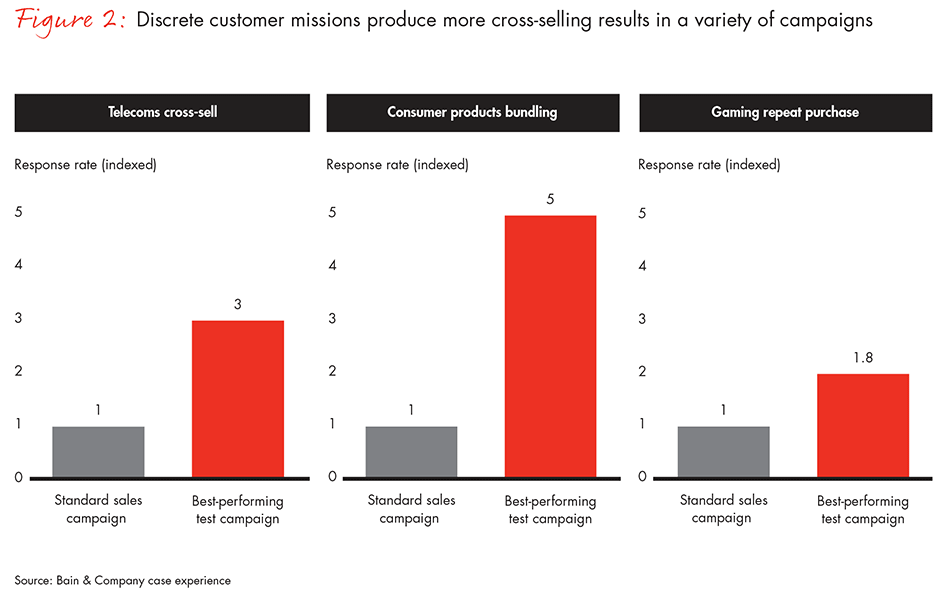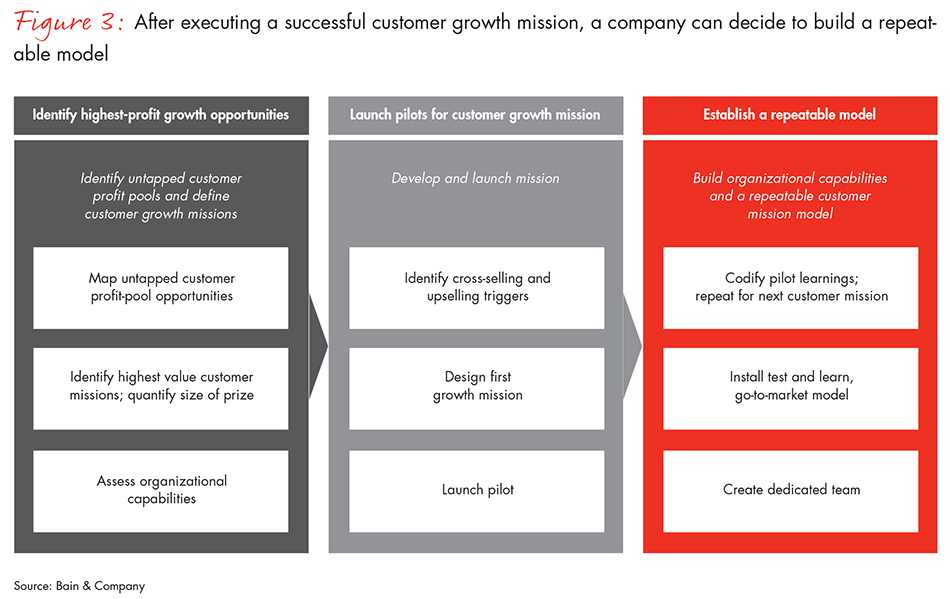Brief

The financial services firm USAA prizes its relationships with customers and consistently earns the highest customer loyalty scores in the industry for both US banking and insurance businesses. The high level of trust affords USAA access to copious customer data that it uses to inform personalized cross-selling and up-selling. The company does deep data mining through multiple sources to spot signature events in customers’ lives. Those events trigger USAA to contact the customer at just the right time with just the right offer, such as auto insurance when a customer’s daughter is about to turn 16. As a result, USAA outperforms most competitors in the number of products held by its customers.
USAA is something of an exception though. Many firms still underinvest or underachieve in growing share of wallet with existing customers, compared to their investments and initiatives in acquiring new customers. Why?
An economic argument for a focus on cross-selling seems obvious. The incremental cost to sell is typically lower, because existing customers already know the brand and likely the product or service on offer. Tenure typically is longer, because existing customers have already traversed the “get to know you” stage, when defection rates are highest. In the insurance industry, for instance, customer churn drops sharply as an insurer sells customers another one or two products, a new Bain & Company consumer survey found. Surely the return on investment (ROI) must be higher than acquisition marketing.
True, but marketers care about more than ROI; unit volume and revenue per period also matter. Excelling on those metrics has been a challenge, because the base of existing customers may be much smaller than the universe of prospects, so existing customers must respond at much higher rates to move unit volume and revenue. And marketers have struggled to deliver higher response rates, given data challenges, limited direct marketing channels and flaws in the customer experience.
John Senior, a partner with Bain’s Customer Strategy & Marketing practice, discusses how companies can overcome organizational barriers and reap greater returns by investing in their customers.
Why the time is ripe
Fortunately, several trends have converged in recent years to break through these barriers to achieving higher response rates:
- Data explosion. The proliferation of customer data, along with greater computing power to organize and analyze this data, makes it feasible to create much more dynamic and insightful profiles of customers. These profiles enable organizations to develop compelling value propositions and target customers with precise offers at the opportune time.
- Digital investments. Online and mobile channels now allow companies to interact with customers on an individual and customized basis around the clock. They can fine-tune marketing messages and offerings based on observed behavior, learning what works in real time for different customers.
- Loyalty investments. Many companies have made significant investments to improve their customers’ experience in order to generate greater loyalty. These investments have earned them greater leeway to cross-sell—but they still have to ask customers. And the sooner the better: Cross-selling rates tend to level off in some industries after about three months following the initial purchase.
These favorable changes have motivated marketers to reassess cross-selling priorities. For example, Bain & Company’s recent analysis in the US telecommunications industry found that up to 60% of customers split their services across multiple providers for mobile phone, landline, TV or Internet services. For one telecoms provider, convincing just 10% of these customers to switch one service from a competitor was worth up to $480 million of incremental annual revenue. Converting 10% of customers to take all their services from one provider could be worth up to $630 million (see Figure 1). The resulting decline in customer churn multiplies this effect several fold. The same story applies in retail banking, insurance, credit cards, retail and other industries.

Marketers also are trying new strategies to raise response rates and capture greater share of wallet. For example, Sephora’s “Beauty Insider” loyalty program captures more than 80% of all customer transactions in order to personalize its online shopping. The company targets Apple Passbook (digital wallet) users, who were spending about twice the level of other customers and buying more frequently as of 2013, when the latest data was available. Such efforts helped Sephora capture more than 20% of the US cosmetic and fragrance market by 2013, Forbes reported.
For many companies, though, the biggest barriers are inside their organizations. Managers who want to grow share of wallet and sharply raise the productivity of their cross-selling efforts may have to confront long-standing practices that stand in the way. To that end, here are five practical guidelines for expanding share with current customers.
1. Take a balance-sheet view
Many businesses organize around product lines and focus on achieving quarterly, monthly or even weekly targets. Although this centers the organization on achieving in-year goals, it often hinders efforts to maximize the long-term value of customer relationships. Effective cross-selling organizations, such as American Express, complement the P&L perspective with a longer-term, balance-sheet view of the business and a multi-year view of customer value. This holistic perspective allows them to invest appropriately in creating and implementing multiyear growth strategies to achieve sustainable, longer-term growth, and to make better trade-offs between in-year and multiyear objectives.
2. Create dynamic, high-resolution customer profiles
Managers might think they understand their customers, but they often use blunt tools that cannot produce insight and context. Many customer relationship management (CRM) systems, for instance, often provide only cursory data to a sales agent’s computer screen, and that does not enable effective cross-selling.
With the exponential growth in data and the increased computing power available, companies can now combine internal and external data spanning several years to build dynamic, higher-resolution customer profiles. These profiles allow managers to uncover insights that can be used to develop better value propositions and effective cross-selling strategies. For example, a longitudinal view of a customer relationship provides rich insights into how the customer’s product usage has changed over time, how he or she has migrated among products, and which triggers or leading indicators caused changes in behavior. Understanding the triggers is essential for designing effective share-of-wallet growth strategies.
3. Focus on discrete, high-value customer growth missions
When companies set customer growth goals, they too often pursue overly broad or diffuse objectives, such as “Let’s sell home insurance to all high-value auto insurance customers,” rather than identifying and focusing on the pockets of greatest opportunity.
Defining a high-value customer growth mission, by contrast, narrows the aperture to focus on the organization. An example of such a discrete customer mission might be: “Let’s target our high-value customers who are in the market for home insurance and are customers of competitor X, which has low loyalty scores.”
Defining customer missions takes work. Companies must understand the most profitable customer segments, how their behaviors and preferences have changed over time, the products and channels they use, and how they stack up against the competition in each area. And they must calculate the real economic value of these segments, so that they can create targeted and tailored strategies that will be profitable.
One large US telecom company wanted to create a program to systematically increase the value of its existing customer base. It combined more than 200 data elements from 15 marketing, service and operations databases to create high-definition portraits of all its customers. The company used these portraits to design cross-selling marketing tests targeted at high-potential customers who demonstrated a high level of product engagement, because the data showed that these customers were more likely to upgrade. This tactic resulted in a threefold increase in cross-sales, accelerated learning about what elements customers responded to and a far higher return on marketing investment (see Figure 2).

4. Just get started—test and learn
It’s a common misconception that a company must invest in new data warehouses or CRM systems before taking action. In fact, organizations can mobilize quickly around internal data that resides in existing databases, assemble external market data in a few weeks and often use analytical tools that exist in-house. We have found that when an organization exploits existing data, it can start to log share-of-wallet victories quickly.
MGM Resorts was looking to raise booking rates among existing customers at its casino/resort properties in Las Vegas. Its past direct marketing email campaigns were based on traditional A/B or champion/ challenger tests, which had produced mixed results. MGM decided to try a new approach and launched a multivariate campaign using “experimental design.”
The campaign tested five attributes with two to four variations each, including different offer packages (for example, a room discount versus a coupon to play slot machines), travel windows, brand messages and email frequency. At the end of the campaign, experimental design allowed MGM to model response rates for every possible combination of variables—288 in all. For one set of target customers, the best combination of variables achieved a 180% lift in bookings over the control offer, worth millions in incremental revenue when extrapolated to the full set of customers. Moreover, MGM learned how different groups of customers—say, gamblers and non-gamblers—responded differently to each offer. To keep the insights coming, MGM has set up a new cross-functional test-and-learn team, which has continued to introduce new variations with these customer groups.
5. Build a repeatable model
The path to sustainable share-of-wallet growth often requires changes to an organization’s go-to-market system. For example, corporate functions such as marketing, sales, product and finance should align to effectively execute a customer growth mission. The test-and-learn approach allows a firm to try a dry run of a new go-to-market model, log some early wins, build new capabilities and iron out the kinks as the organization learns how to work in a different rhythm. Leaders can then decide if it makes sense to create a new team dedicated to share-of-wallet growth, and possibly to invest in building new capabilities or installing new technologies (see Figure 3).

Conditions are right for companies to reinvigorate their share-of-wallet strategies. Now it’s up to managers to harness the wealth of customer data, advanced analytic techniques and the power of digital channels to create and launch customer missions. Companies that outperform in these missions will be able to systematically grow their share of spending among loyal customers.
John Senior is a partner with Bain & Company’s Telecommunications, Media & Technology practice, and is based in Sydney. Tom Springer and Lori Sherer are co-leaders of Bain’s Advanced Analytics practice. Springer is based in Boston and Sherer is based in San Francisco.


